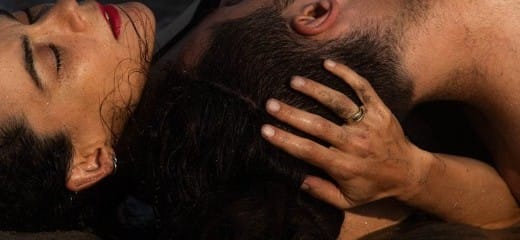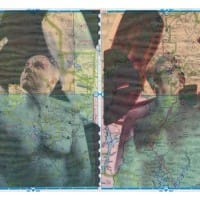Leaving the crowded sidewalks and nonstop advertising of Times Square, the subway to Rockaway Beach, Queens, takes about ninety minutes. Approaching the site of Faye Driscoll´s Oceanic Feeling along the stretch of sand between Beach 105th and 108th Streets, one wonders if this is still New York City.
For the 10th annual Beach Sessions Dance Series, organized by Sasha Okshteyn and Morgan Griffin, Driscoll’s site-specific piece was lit by the slowly setting sun on Labor Day. Three to four hundred audience members created an L-shaped frame for the sixteen performers, dressed in simple swimwear and many topless, whose movements hovered along the edge of stillness for nearly two hours. From my initial vantage point, the placement of the performers reminded me of points along a sundial, their spatial arrangement emphasizing perspective and an invitation to appreciate relationships stretching out towards the distance. Each mover slowly articulated their bodies with strength and control, some gestures evoking yearning, while others´ kneeling backbends registered as reverential, an appeal to unseen deities above. Eventually, I discovered that some of her performers, though fifty feet apart, moved in unison, and that their movement phrases repeated in fifteen minute cycles. Subtle, but a clear indicator of Driscoll´s choreographic craft.
As the company made its slow trek from sand to the edge of the sea, I was impressed that so many New Yorkers maintained such a clear boundary for this piece. In addition to natural lighting, the movement and spatial languages of Oceanic Feeling incorporate whatever occurs within the environment. I was struck by the contrast of the performers´ gestures along with a plane passing overhead to land at nearby JFK, the abrupt sound of a baby crying or a dog barking while a mover slowly rolled their body across the sand. While most members of the public at first avoided “disrupting” the performance area, more than a few walked to or from the water as the piece unfolded. Behind me, someone asked, “What are they doing?” Another asked a friend, “Is this a dance?”
Driscoll’s durational work invites audiences to gaze, to pay closer attention to all of the movements constantly occurring around us. Compared to Oceanic Feeling´s determined slowness, the rippling surface of the nearby ocean seemed almost fast and frenetic. Until the very end of the work, when they slowly entered the sea, the dancers´ poetic choices appeared to ignore gravity and momentum.
Oceanic Feeling lacks obvious development, and its progress from beginning to end is quite simple. Observing the piece unfold, I thought of Andy Warhol´s 1965 film Empire, or the generative ambient composition Reflections by Brian Eno. Like these, Driscoll’s project doesn´t require a viewing from start to finish; Oceanic Feeling became a kind of backdrop for at least a third of the public who attended the performance. Folks gazed upon the piece, then spoke to their friends, then opened another beer from the cooler, sometimes all at the same time, without any concern over “missing” anything from the piece. Durational pieces like these engage the viewer in a different way than a conventional dance performance; each audience member has greater agency over how they interact with the piece.
Once the performers stepped into the water, their movements became more partnered. Couples would cradle or caress each other, and later, they created larger formations with their interlocking limbs, as if they could assemble a sea vessel out of their bodies and float away along the tide together. (Driscoll’s 2023 work Weathering had created a human raft of a far different order).
However, these moments became increasingly difficult to discern as more and more people–many with cameras and taking phone videos–crowded towards the front, making it nearly impossible to see. For such an elemental piece, it seemed surreal to “watch” the final twenty minutes of Oceanic Feeling through the small screens of nearby cell phones held above by strangers, even though we all stood mere feet away. This left me wondering: is even our liminal seaside environment truly free from our handheld devices?
Oceanic Feeling, Faye Driscoll, Beach Sessions Dance Series, Rockaway Beach, Queens, Sept 2.
Home page image: “entangled” – With the ocean in the background, we only see the back of a man wearing a dirty blue shirt, James Barrett. He is reaching his hands behind him to touch another man, Miguel Alejandro Castillo, who wears red shorts and his lying on his back.
Article image: “hug” – Mor Mendel, a woman with black hair, hugs the head of David Guzman close to her shoulder, as the two lie on the wet sand. On her hand we see a gold ring.






